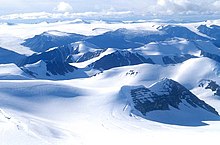Nunatak



Nunatak ( Inuktitut and Kalaallisut : Nunataq ., Literally, that made from land '; plural German nunataks , Nunataker and Nunatakr , often Danish form Nunatakker ; Inuktitut Nunatait , Kalaallisut Nunatat ) referred to in the Glaciology an insulated, over the surface of glaciers and Inland ice masses towering rock or mountain. This rock is thus surrounded by a network of ice streams. Nunatakker are mostly found on the edges of ice sheets . The term nunatak is also used more rarely for ice-free areas surrounded by glaciers such as the Antarctic dry valleys , during the ice ages, for example, low-lying regions of Baffin Island and Labrador , and not exclusively for elevations.
Nunatakker during the Ice Ages
The “nunatak hypothesis” assumes that the nunataks formed important retreats ( refuges ) for many animal and plant species in the icy areas during the ice ages . According to this theory, these islands in the ice played an important role in the survival of plant species. It is now believed that nunatakkers were of little importance in the survival of species and that these survived the cold ages in other places. As a result, the formerly mainly glaciated areas have largely been repopulated from the outside (" Tabula-rasa hypothesis").
For the Alps-Carpathian region, the nunatak hypothesis is being considered for species such as the Himmelsherold , the Dolomite cinquefoil , the Swiss man's shield or the Alpine carnation .
For the development of the vegetation in Northern Europe, it has been discussed so far whether some regions on the west coast of Norway, in particular fells around the central Sognefjord and north of the Arctic Circle as far as Finnmark , could have been ice-free refuge areas, to the existence of endemic poppy species in Norway or the local occurrence by species such as Rhododendron lapponicum and Carex scirpoidea , the closest areas of which are in Greenland and North America.
However, the ice thicknesses on which this hypothesis is based are questioned: Often attempts are made to determine the former ice age thicknesses based on the traces left by ice age glaciers on the nunatak cores around which they have flown. This method is viewed as unreliable, as traces of the ice in the summit regions are poorly preserved due to post-glacial weathering . In addition, according to more recent findings, pre-glacial weathering phenomena such as block fields, which have long been regarded as signs of a lack of glaciation, can also survive long ice cover. It must therefore be assumed that the ice age ice sheets were in some areas thicker than assumed based on these phenomena and that many of the supposed former nunataks were actually completely covered by the ice.
It is different in the high mountains, where the upper edges of the ice stream can be reconstructed from clear traces of the inner mountain areas for the peripheral zones as well. There, questions primarily arise about local glaciation (formation of nutrient areas) of the peaks protruding from the ice flow network.
literature
- Eilif Dahl: The Nunatak Theory Reconsidered . Research in Arctic Life and Earth Sciences. Present Knowledge and Future Perspectives: Proceedings of a Symposium Held September 4-6, 1985, at Abisko, Sweden. In: Mats Sonesson, Naturvetenskapliga forskningsrådet, Forskningsrådsnämnden (ed.): Ecological Bulletins . No. 38 . Blackwell Publishing, Abisko 1987, ISBN 87-16-10034-4 , pp. 77–95 ( limited preview in Google Book search).
Web links
Individual evidence
- ↑ According to Duden.
- ^ RJ Rogerson: Nunatak ( English, French ) In: The Canadian Encyclopedia . Retrieved August 22, 2016.
- ↑ a b Nunatak. Encyclopaedia Britannica, accessed November 17, 2008 .
- ↑ Holderegger, R., Thiel-Egenter, C. (2009): A discussion of different types of glacial refugia used in mountain biogeography and phytogeography. Journal of Biogeography 36, 476-480. pdf version
- ↑ Dahl, p. 77
- ↑ Klaus Dierßen: Vegetation Northern Europe. Verlag Eugen Ulmer, Stuttgart 1996. pp. 59-63.
- ↑ Håvard Juliussen, Ole Humlum: Preservation of block fields beneath Pleistocene ice sheets on SØlen and Elgåhogna, central-eastern Norway . In: Journal of Geomorphology . tape 51 , no. 2 . E. Schweizerbart'sche Verlagsbuchhandlung, November 2002, ISSN 1864-1687 , p. 113-138 , doi : 10.1127 / 0372-8854 / 2007 / 0051S2-0113 ( abstract [accessed November 18, 2008]).
- ↑ George H. Denton, Terence J. Hughes: The Last Great Ice Sheets . John Wiley & Sons, New York 1981, ISBN 0-471-06006-2 , pp. 292-293 .